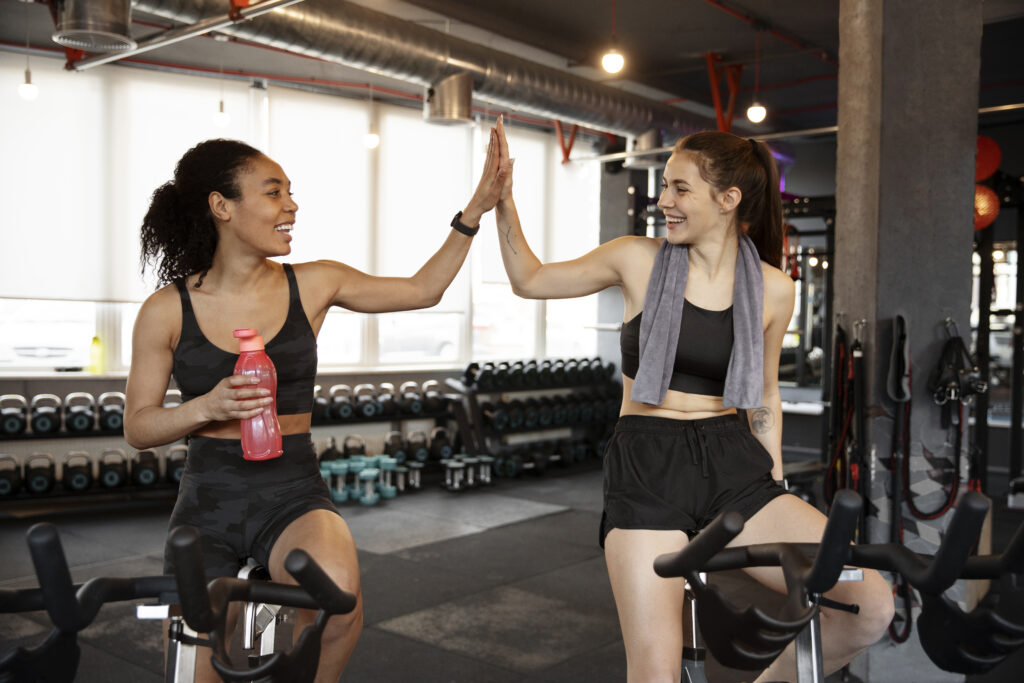Anyone entering the fitness arena trying to improve their physique, mental health, body flexibility, weight control, stamina, or overall lifestyle performance must address several milestones step-by-step. The first one requires a decision on the resource pool that will deliver the visualized benefits. The options, in a broad sense, are straightforward:
- Join a brick-and-mortar gym.
- Opt for training programs that don’t rely on traditional gym attendance.
- Elect a hybrid option that includes both.
The solution that fits you best must accurately settle on an optimal balance of your lifestyle, budget, goals, and personality characteristics. For example, here are some of the primary questions that are front and center of the conversation:
- Do my job and family commitments allow me to attend a gym on an organized schedule?
- Should my fitness training program fit flexibly into my lifestyle, or must I change the latter to meet the program’s demands?
- How much weight should I place on my fitness objectives if it involves significant shifts in my daily routine?
- Do I need people around me in a similar environment training and sweating to give me enough motivation to get through a tough session?
- Am I a group session type of exerciser, or do I prefer a more private, customized, and personalized direction?
- How much can I rely on my own guidance to train effectively?
- Is a personal trainer module or person vital to maintaining a fitness schedule long-term?
- How much variance do I need in the program I select to prevent me from becoming bored and, therefore, demotivated?
- How much vital performance metric monitoring do I need in real-time (e.g., calorie count, heart beats per minute, etc.)?
- How much can I afford to fund my fitness goals monthly and as an initial investment for equipment if I select a home gym option?
- Can I fit a home gym into the place where I live or my office?
- Am I looking for more than just a workout, such as joining an exciting new culture or social framework?
There are dozens more I can think of. However, answer the ones above, and you’ll get a pretty good idea of the direction you want to go. The most important thing to remember in this soul-searching process is
that your responses should be truthful(i.e., honest with yourself) andbased on objective, accurate, and relevant information. The remainder of this article will deliver the latter so you can decide with all relevant influences in the equation.
Whatever you decide, you need equipment and space to train correctly
Depending on your fitness vision, here are the relevant categories that make training possible in either a commercial or home gym setup. You need to select the combination that suits your needs in the most seamless and least stressful manner:
- For cardio-aerobic exercising: The primary options cover verticals such as the treadmill, exercise bike, rowing machine, or elliptical trainer.
- For strength-training, muscle-building, or body culture exercises:
Consider hydraulic resistance machine options (legs, arms, torso, and back), dumbbells, kettlebells, ropes, yoga mats, resistance bands, and studio space. - Stretching and stress-releasing: Yoga and Pilates.
- Group sessions: This covers virtual access to group workouts or brick-and-mortar studio space for kickboxing, spinning, and specialized sessions to develop strength and stamina.
Evaluating traditional gyms
You can be sure going the traditional “gym-near-me” route will, at first glance, offer equipment options that are at least adequate. Busy, bustling entities with members constantly moving in and out will have them in abundance. However, that’s not where your key focus should be.
In my view, the critical decisions around the latter depend on the following questions and considerations:
- The traffic congestion in the gym around the time you want to train. It doesn’t matter how many units are available, if there’s a queue to get on them and limited time restrictions in using them it’s far from ideal.
- The equipment condition and upgrade level: Does it meet the latest technology standards, and are repairs attended to quickly? Flashing alert signals warn you something’s amiss if you walk into a space where you see and encounter:
- “Out of order” signs pinned to apparatus in all directions.
- Yester-years’ creaky, antiquated tools.
- The focus on hygiene in the change rooms, equipment cleaning, and environmental maintenance must be second to none.
- Don’t ignore supplementary facilities like towels, showers, lockers, refreshments, and personal trainers. They are integral components of the gym package offered and the fee it’s charging.
- Can you sync your wearable technology and go-to fitness apps with the gym’s in-house IT? In this regard, does the gym offer a dedicated brand app that allows virtual connection with classes when you want to stay home or travel?
- Does the demographic, cultural, and social profile of the gym fit your profile like a hand in a glove?
Gyms come in all shapes and sizes, from $10 to $400 monthly fees, providing a broad range of value-for-money options. Everything under the sun exists in US cities, from “bare-bones, no frills, bring your own towel, train-and-leave in your sweats establishments” to super-luxury resort-style training experiences.
Gym owners’ position on the experience curve and ability to leverage scale advantages should play into your decision. For example, should you choose a big fitness chain or a standalone gym? From price to location to amenities, your choice might vary depending on your requirements.
- One can benefit substantially from relatively low fees at large chain brand names offering sleek, streamlined, and upgraded equipment options.
- Conversely, a mom-and-pop, hole-in-the-wall gym a block away from your home may sell itself purely on fantastic convenience, offering Spartan-like facilities and outdated tools for relatively higher fees.
- From another angle, paying for amenities and services you don’t need may make no sense. However, it does if it looks less appealing to overpay for limited-range facilities that over-charge
So, the bottom line is this: If a formal gym is a serious consideration, you must research, research, and when done, research some more. Ask for free trial sessions (most will grant you that). Get a good feel for the place and ask yourself the following four critical questions:
- Is this an environment I’ll look forward to returning to weekly?
- Will it continuously bother me that I’m paying for so much I’m not taking advantage of in this gym?
- Can I live with the advantages they don’t offer?
- Can I pay these fees sustainably long-term?
A “Yes” to (2) above or “No” to any of the others are kill points to gym under focus being a candidate. If so, move on to the next.
Remember, the formal fitness industry is mature. It signifies that gym and fitness center stakeholders have learned from past errors and pitfalls, getting their value proposition together with a pricing structure that resonates with their target segments. You’ll eventually hit the one that’s a balanced, if not perfect, match.
Home-Gym Options
Here’s where things genuinely get exciting. The ideal home gym size is 400 x 200 feet if you want to move between strength-building and aerobic apparatus. However, if you have a limited focus on one or the other, eight by seven feet in the bedroom or lanai is enough.
There’s so much in favor of working out at home or on the move, delivered by the digital era, its technology advancements, and equipment designed for residential deployment. The field is too vast to cover brand by brand, so I’ve picked the most reputable fitness equipment with excellent reviews as examples of what’s available. Pivot off these to expand your research with an understanding of what’s possible.
Another article’s subject is the extra dimensions delivered by wearable apps collaborating with dedicated home workout sessions (see below).
Cardio Equipment
1. Treadmills
On the premium end of this home gym option pool, you want reliable, versatile apparatus with innovative technology (to sync with your wearables and apps) and portable folding features to optimize your space and dynamic lifestyle.
An example you might consider is the NordicTrack 1750, winner of coveted awards, a sturdy machine with excellent service and warrant backup offering integrated iFit and HD touchscreen streamable classes as a compelling option. Several running coach endorsements provide that extra dose of confidence. Expect to pay around $2,000.
Too much money? The Horizon T101 represents the best value in the lower price category at $649. Who does this suit best? Hard-core joggers who know how to run their selected distances and don’t need a full house of bells and whistles. Still, this model represents impressively high-quality finishes.
Bring your own iPad entertainment to the party, and you’ll be in for a treadmill experience that closes the feature gaps quickly.
2. Stationary Bikes
Stationary bikes are the number one choice for low-impact cardio exercise, with options ranging from $400 for “no-frills-just-pedal” editions available from Walmart to the Peloton bike for $2,500. The latter arrives in your space as a sleek, streamlined, made-for-athletes machine, “super comfortable,” and a cinch to ride.
Its signature feature outside of the “Just Ride” program includes modern on-demand and live classes for an in-studio experience with a monthly subscription—adding a virtual gym experience that’s motivating, immersive, and fun.
BowFlex’s C6 magnetic resistance bikes have an $800 tab and LCD screens reflecting speed, calories, watts, and distance stats. They also provide the advantage of an iPad stand, connecting to the same virtual classes as Peloton and other high-end models.
Low-priced recumbent-style rides come no better than the Merach 19 (around $450) – a no-frills option that seamlessly connects to virtual app classes via your preferred devices. Users rave about its breathable, versatile, and comfortable anti-sweat mesh seating.
3. Ellipticals and Rowing Machines
Rowing is an extraordinary exercise regimen, strengthening upper and lower body muscles while competing cardio-wise with the bikes and treadmills. It’s little wonder that Olympic rowers are among the most impressive endurance athletes at the games.
Ellipticals stand out as the lowest impact cardio method closest to running. It exerts more calorie use pressure than any other of the mentioned equipment categories. Together with rowing, it’s squeezed into the aerobic arena, adding welcome variety to the exercise type. In this case, I advise not buying off a diagram but trying it out in a distribution location.
Why? The brands offer different body positions that suit some heights better than others. You must feel connected with the machine, not shift around to find a comfortable position.
These two categories follow the same feature patterns as treadmills and stationary bikes, with luxury, virtually integrated models at the top end, such as the $1800 NordicTrack FS10i Interactive Elliptical Trainer and the $1,500 Hydrow Wave Rower.
Tight-budget buyers seeking low prices with long-lasting quality will find the Niceday Elliptical Machine ($600) and Concept2 RowErg at $1,000 fit the bill nicely.
4. Jump Ropes
Speed jump ropes between $35 and $150 are the least expensive but incredibly effective cardio workout tools. The top brands (Sonic Boom and Crossrope) include models with Bluetooth-connected handles that count your reps, guide your skipping workouts, and even offer ropeless sets for users who want to avoid scuffing walls, floors, and being tripped up.
Strength Training and Stretching
This crucial training aspect focuses on the equipment required for bodybuilding, strength, agility, and flexibility. There are four primary headings below:
1. Dumbbells and Kettlebells
Bowflexx’s SelectTech 552 Adjustable Dumbbells ($379) and SelectTech 840 *$149) Adjustable Kettlebells are all-in-one options that give you every weight combination with compact, efficient, ergonomic designs. No racks or wasted space, simply select your poundage and lift.
2. Medicine Balls
These are dependable weight-training assets you should have in your home gym to cover muscles in the legs, arms, and core. Indeed, you can access apps that include entire workouts with this single equipment category, integrated with throwing exercises like slams and crunches (abdomen-loaded). The Prosource Soft Medicine Ball ($70) is all you need.
3. Wearable Weights (WWs)
Wrist and ankle WWs fit in with various cardio, strength, or stretching routines, adding that extra degree of toughness and ramping up the calorie count per minute. The key here is comfort and non-interference with the primary exercises they complement. Your best choices here are aesthetically pleasing with practical velcro fasteners: Henkelion (Adjustable Ankle Weights) and Bala Bangles (around $75 for both).
4. Resistance Bands and Yoga Mats
These complete your home gym, doubling up as ideal travel items for workouts in your hotel room, guided by dedicated virtual apps that deliver fulfilling workouts with no other equipment necessary. Worried about the most common band complaint (snapping under pressure) with extra-strength materials? You can buy Fit Simplify (Resistance Loop Exercise Bands) or Committed HP (The Better Band) for between $9 and $17. Want to address mat pain points that include “slipping, awkward sizes, too thin, and smelly.” The following are “grippy, thick, extra-length,” and “easy to clean” options: Manduka (Pro Yoga Mat 6mm), Lululemon (The ‘Big’ Mat, and the Stakt Mat from $88 to $160.
Conclusion
Everything above covers the pros and cons of attending a commercial gym, constructing your own at home, or combining the two. To complete the picture, you must invest in app subscriptions and wearable technologies to monitor fitness progress.
You may even splurge on a Lululemon Studio (previously The Mirror) – a virtual seven-foot oblong interactive mirror projecting live or on-demand virtual fitness instruction classes to your home gym. We’ve dealt with this as another topic under a separate content piece in our article on how wearable technology has revolutionized fitness training.
If you’ve read this far, you’ve seen that there’s no excuse for putting off your fitness goals. You can join a respectable gym for as little as $10 monthly or invest in a fully equipped home gym covering cardio, strength, and stretching for less than $1,000.
Of course, the maximum elaboration of the latter can take one’s budget to over $7,000 if you want every exercise option at your fingertips (excluding the digital apps and technology wearables – another discussion). Super-luxury professional fitness center attendance can go as high as $400 monthly. You can elevate every workout experience with smart insights having with a fitness experience platform. The takeaway is that staying healthy fits most budgets without compromising the range of physical attention participants require.
FAQs
1. What are the key differences between gym and home workouts?
A. Gyms offer equipment and structure; home workouts provide flexibility and convenience.
2. Is a gym workout more effective than a home workout?
A. Both can be equally effective with the right plan, consistency, and goals.
3. Which is more budget-friendly: gym or home workout?
A. Home workouts usually cost less over time, while gyms require ongoing membership fees.
4. What equipment do I need for a good home workout?
A. Basic equipment like resistance bands, dumbbells, and yoga mats can suffice for most home routines.
5. Can I combine gym and home workouts?
A. Yes. A hybrid routine offers flexibility, variety, and balance in your fitness journey.
Editor’s note: The author’s recommendations are his own.












